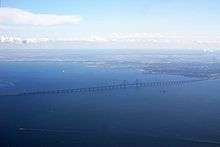Øresund Bridge
The Öresund or Øresund Bridge (Danish: Øresundsbroen [ˈøːɐsɔnsˌpʁoˀn̩]; Swedish: Öresundsbron [œrɛˈsɵ̂nːdsˌbruːn]; hybrid name: Øresundsbron) is a combined railway and motorway bridge across the Öresund strait between Sweden and Denmark. The bridge runs nearly 8 kilometres (5 miles) from the Swedish coast to the artificial island Peberholm in the middle of the strait. The crossing is completed by the 4-kilometre (2.5 mi) Drogden Tunnel from Peberholm to the Danish island of Amager.
Øresund Bridge Öresund Bridge | |
|---|---|
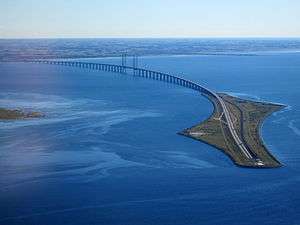 | |
| Coordinates | 55°34′31″N 12°49′37″E |
| Carries | Four lanes of European route E20 Double-track Øresund Line |
| Crosses | Øresund strait (the Sound) |
| Locale | Copenhagen, Denmark and Malmö, Sweden |
| Official name | Øresundbron (used by company), Øresundsbroen, Öresundsbron |
| Characteristics | |
| Design | Cable-stayed bridge |
| Total length | 7,845 metres (25,738 ft) |
| Width | 23.5 metres (77.1 ft) |
| Height | 204 metres (669 ft) |
| Longest span | 490 metres (1,608 ft) |
| Clearance below | 57 metres (187 ft) |
| History | |
| Designer | Jorgen Nissen, Klaus Falbe Hansen, Niels Gimsing and Georg Rotne |
| Engineering design by | Ove Arup & Partners Setec ISC Gimsing & Madsen |
| Constructed by | Hochtief, Skanska, Højgaard & Schultz and Monberg & Thorsen |
| Construction start | 1995 |
| Construction end | 1999 |
| Construction cost | 19.6 billion DKK 25.8 billion SEK 2.6 billion Euro |
| Opened | 1 July 2000 |
| Statistics | |
| Daily traffic | ca. 19,000 road vehicles (2014)[1] |
| Toll | DKK 390, SEK 460 or € 54 |
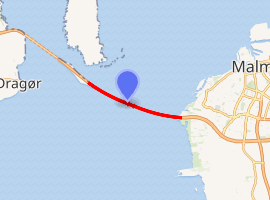
| |
The Øresund Bridge was the longest combined road and rail bridge in Europe from 2000 to 2019, and connects two major metropolitan areas: Copenhagen, the Danish capital city, and the Swedish city of Malmö. It connects the road and rail networks of the Scandinavian Peninsula with those of Central and Western Europe. A data cable also makes the bridge the backbone of internet data transmission between central Europe and Sweden (and, prior to 2016, also Finland).[2]
The international European route E20 crosses via road, the Øresund Line via railway. The construction of the Great Belt Fixed Link (1988-1998), connecting Zealand to Funen and thence to the Jutland Peninsula, and the Øresund Bridge have connected Central and Western Europe to Scandinavia by road and rail.
The Øresund Bridge was designed by the Danish engineering firm COWI. The justification for the additional expenditure and complexity related to digging a tunnel for part of the way, rather than raising that section of the bridge, was to avoid interfering with air traffic from the nearby Copenhagen Airport, to provide a clear channel for ships in good weather or bad, and to prevent ice floes from blocking the strait.
The Øresund Bridge crosses the border between Denmark and Sweden. Although the Schengen Agreement and the Nordic Passport Union should mean no routine passport inspections, since January 2016, identity and visa checks have been imposed by Sweden on travellers from Denmark due to the European migrant crisis.[3]
Construction began in 1995, with the bridge opening to traffic on 1 July 2000. The Øresund Bridge received the 2002 IABSE Outstanding Structure Award.
History
Ideas for a fixed link across the Øresund were advanced as early as the first decade of the 20th century. In 1910, proposals were put to the Swedish Parliament for a railway tunnel across the strait, which would have comprised two tunnelled sections linked by a surface road across the island of Saltholm.[4] The concept of a bridge over the Øresund was first formally proposed in 1936 by a consortium of engineering firms who proposed a national motorway network for Denmark.[5][6]
The idea was dropped during World War II, but picked up again thereafter and studied in significant detail in various Danish-Swedish government commissions through the 1950s and 1960s.[5] However, disagreement existed regarding the placement and exact form of the link, with some arguing for a link at the narrowest point of the sound at Helsingør–Helsingborg, further north of Copenhagen, and some arguing for a more direct link from Copenhagen to Malmö. Additionally, some regional and local interests argued that other bridge and road projects, notably the then-unbuilt Great Belt Fixed Link, should take priority.[5] The governments of Denmark and Sweden eventually signed an agreement to build a fixed link in 1973.[7] It would have comprised a bridge between Malmö and Saltholm, with a tunnel linking Saltholm to Copenhagen, and would have been accompanied by a second rail tunnel across the Øresund between Helsingør and Helsingborg.[8]
However, that project was cancelled in 1978 due to the economic situation,[9] and growing environmental concerns.[10] As the economic situation improved in the 1980s, interest continued and the governments signed a new agreement in 1991.
An OMEGA centre report identified the following as primary motivations for construction of the bridge:[10]
- to improve transport links in northern Europe, from Hamburg to Oslo;[10]
- regional development around the Øresund as an answer to the intensifying globalisation process and Sweden's decision to apply for membership of the European Community;[10]
- connecting the two largest cities of the region, which were both experiencing economic difficulties;[10]
- improving communications to Kastrup airport, the main flight transportation hub in the region.[10]
A joint venture of Hochtief, Skanska, Højgaard & Schultz and Monberg & Thorsen (the same of the previous Great Belt Fixed Link), began construction of the bridge in 1995 and completed it 14 August 1999.[11] Crown Prince Frederik of Denmark and Crown Princess Victoria of Sweden met midway across the bridge-tunnel on 14 August 1999 to celebrate its completion.[12] The official dedication took place on 1 July 2000, with Queen Margrethe II, and King Carl XVI Gustaf as the host and hostess of the ceremony.[13] Because of the death of nine people, including three Danes and three Swedes, at the Roskilde Festival the evening before, the ceremony opened with a minute of silence.[14] The bridge-tunnel opened for public traffic later that day. On 12 June 2000, two weeks before the dedication, 79,871 runners competed in Broloppet, a half marathon from Amager, Denmark, to Skåne, Sweden.[15]
Despite two schedule setbacks – the discovery of 16 unexploded World War II bombs on the seafloor and an inadvertently skewed tunnel segment – the bridge-tunnel was finished three months ahead of schedule.
Although traffic between Denmark and Sweden increased by 61 percent in the first year after the bridge opened, traffic levels were not as high as expected, perhaps due to high tolls.[16] However, since 2005, traffic levels have increased rapidly. This may be due to Danes buying homes in Sweden to take advantage of lower housing prices in Malmö and commuting to work in Denmark. In 2012, to cross by car cost DKK 310, SEK 375 or €43, with discounts of up to 75% available to regular users. In 2007, almost 25 million people travelled over the Øresund Bridge: 15.2 million by car and bus and 9.6 million by train. By 2009, the figure had risen to 35.6 million by car, coach or train.[17][18]

Link features
Bridge
At 7,845 m (25,738 ft), the bridge covers half the distance between Sweden and the Danish island of Amager, the border between the two countries being 5.3 km (3.3 mi) from the Swedish end. The structure has a mass of 82,000 tonnes and supports two railway tracks beneath four road lanes in a horizontal girder extending along the entire length of the bridge. On both approaches to the three cable-stayed bridge sections, the girder is supported every 140 m (459 ft) by concrete piers. The two pairs of free-standing cable-supporting towers are 204 m (669 ft) high allowing shipping 57 m (187 ft) of head room under the main span, but most ships' captains prefer to pass through the unobstructed Drogden Strait above the Drogden Tunnel. The cable-stayed main span is 491 m (1,611 ft) long. A girder and cable-stayed design was chosen to provide the specific rigidity necessary to carry heavy rail traffic, and also to resist large accumulations of ice. The bridge experiences occasional brief closures during very severe weather, such as the St. Jude storm of October 2013.[19]
Due to high longitudinal and transverse loads acting over the bridge and to accommodate movements between the superstructure and substructure, it has bearings weighing up to 20 t each, capable of bearing vertical loads up to 96,000 kN in a longitudinal direction and up to 40,000 kN in transverse direction. The design, manufacturing and installation of the bearings were carried out by the Swiss civil engineering firm Mageba.[20]
Vibration issues, caused by several cables in the bridge moving under certain wind and temperature conditions, were combatted with the installation of compression spring dampers installed in pairs at the centre of the cables. Two of these dampers were equipped with laser gauges for ongoing monitoring. Testing, development and installation of these spring dampers was carried out by specialists European Springs.[21]
Peberholm
The bridge joins Drogden tunnel on the artificial island of Peberholm (Pepper Islet). The Danes chose the name to complement the natural island of Saltholm (Salt Islet) just to the north. Peberholm is a designated nature reserve built from Swedish rock and the soil dredged up during the bridge and tunnel construction, approximately 4 km (2.5 mi) long with an average width of 500 m (1,640 ft). It is 20 m (66 ft) high.
Drogden Tunnel
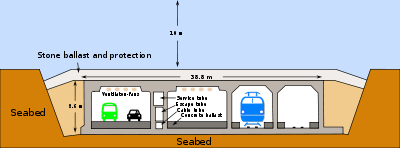
The connection between Peberholm and the artificial peninsula at Kastrup on Amager island, the nearest populated part of Denmark, is through the 4,050-metre (13,287 ft) long Drogden Tunnel (Drogdentunnelen). It comprises a 3,510-metre (11,516 ft) immersed tube plus 270-metre (886 ft) entry tunnels at each end. The tube tunnel is made from 20 prefabricated reinforced concrete segments – the largest in the world at 55,000 tonnes each – interconnected in a trench dug in the seabed. Two tubes in the tunnel carry railway tracks, two carry roads and a small fifth tube is provided for emergencies. The tubes are arranged side-by-side.
Rail transport
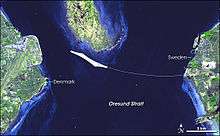
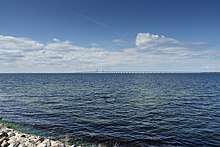
The rail link is operated jointly by the Swedish Transport Administration and Danish railways. Passenger train service is commissioned by Skånetrafiken and the Danish transport agency under the Øresundståg brand, with Transdev and DSB being the current operators.[22] A series of new dual-voltage trains was developed, linking the Copenhagen area with Malmö and southern Sweden as far as Gothenburg and Kalmar. SJ operates X2000 trains over the bridge, with connections to Gothenburg and Stockholm. Copenhagen Airport at Kastrup has its own railway station close to the western bridgehead. Trains operate every 20 minutes, once an hour during the night, in both directions. An additional couple of Øresundstrains are operated at rush hour. Freight trains also use the crossing.
The rail section is double track 1,435 mm (4 ft 8 1⁄2 in) standard gauge and capable of speeds of up to 200 kilometres per hour (120 mph), slower in Denmark, especially in the tunnel section. There were challenges related to the difference in electrification and signalling between the Danish and Swedish railway networks. The solution chosen is to switch the electrical system from Swedish 15 kV, 16.7 Hz to Danish 25 kV, 50 Hz before the eastern bridgehead at Lernacken in Sweden. The line is signalled according to the standard Swedish system across the length of the bridge. On Peberholm the line switches to Danish signalling, which continues into the tunnel.
Trains run on the left in Sweden, and on the right in Denmark. Initially the switch was made at Malmö Central Station, a terminus at that time. After the 2010 inauguration of the Malmö City Tunnel connection, a flyover was built at Burlöv, north of Malmö, where the two southbound tracks cross over the northbound pair. The railway in Malmö thus uses the Danish standard.
Border checks
Both Sweden and Denmark are signatories to the Schengen Agreement, which removes border and passport controls between two participant countries. However, in January 2016, during the European migrant crisis, Sweden was granted a temporary exemption under the terms of the Schengen Agreement in order to mandate that all travellers across the bridge had photographic proof of identity. As such, travellers into Sweden from Denmark (but not the reverse) must show a valid passport or national ID card (citizens of EU/EEA countries) or passport and entry visa (if required) for nationals of other non-EU/EEA countries. The move marked a break with 60 years of passport-free travel between the Nordic countries.[23]
For the rail connection, these checks were initially enforced by legally requiring the train companies to verify the identities of travellers into Sweden, with a fine of SEK 50,000 as punishment for serving those without such identity documents.[24] This led to the enforcement of checks by private security guards at the rail station in Kastrup airport in Denmark - an unpopular move with passengers, due to the delays imposed[25]
From 2017, Sweden removed this requirement and instead replaced it with more extensive direct checks by the Swedish police on entry into the country. This now takes place on board the train at Hyllie station on trains arriving from Denmark, with the checks at Kastrup fully removed.[26]
The border controls were renewed on 12 May 2019, and will remain in place until 12 November 2019, with likely further temporary renewal after.[27]
Costs and benefits
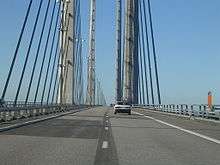
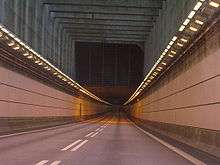
The cost for the Øresund Connection, including motorway and railway connections on land, was DKK 30.1 billion (~€4.0 billion) according to the 2000 year price index, with the cost of the bridge expected in 2003 to be recouped by 2037.[28] In 2006, Sweden began work on the Malmö City Tunnel, a SEK 9.45 billion connection with the bridge that was completed in December 2010.
The connection will be entirely user-financed. The owner company is owned half by the Danish state and half by the Swedish state. This owner company has taken loans guaranteed by the governments to finance the connection and the user fees are its only income. After the increase in traffic, these fees are enough to pay the interest and begin repaying the loans, which is expected to take about 30 years.
Taxpayers have paid for neither the bridge nor the tunnel, but tax money has been used for the land connections. On the Danish side, the land connection has domestic benefits, mainly to connect the airport to the railway network. The Malmö City Tunnel has the benefit of connecting the southern part of the inner city to the rail network and allowing many more trains to and from Malmö.
According to The Öresund Committee, the bridge has made a national economic gain of DKK 57 billion, or SEK 78 billion SEK (~€8.41 billion) on both sides of the strait by increased commuting and lower commuting expense.[29] The gain is estimated to be SEK 6.5 billion per year but this could be increased to 7.7 billion by removing the three biggest obstacles to integration and mobility, the two largest being that non-EU nationals in Sweden are not allowed to work in Denmark and that many professional qualifications and merits are not mutually recognised.[30]
Cultural references
- The Øresund Bridge gave its name to the Nordic noir television series The Bridge, as the series was set in the region around the bridge.
- When Malmö hosted the Eurovision Song Contest in 2013, the Øresund Bridge was used as a symbol for the connection between Sweden and the rest of Europe.
- It was the inspiration behind the 2014 song "Walk Me to the Bridge" by Manic Street Preachers from their album Futurology.[31]
Environmental effects
The underwater parts of the bridge have become covered in marine organisms and act as an artificial reef.
See also
- Fehmarn Belt Fixed Link
- HH Tunnel, a proposed second Øresund fixed link connecting Helsingør and Helsingborg
- List of bridge–tunnels
- List of road-rail bridges
- Old Little Belt Bridge (opened 1935) and New Little Belt Bridge (opened 1970)
- Øresund Region
- Øresundsmetro
References
- Notes
- Data for 2014: 34,087 motorbikes, 6,217,111 passenger cars, 194,495 vans, 50,362 busses, 422,222 trucks, 6,918,277 total (18,954 per day). Trafikstatistik (oresundsbron.com) Archived 12 August 2017 at the Wayback Machine
- "New Baltic data cable plan unfolding". Yle yhtiönä. 11 December 2013. Archived from the original on 14 December 2013. Retrieved 12 December 2013.
According to current plans, the undersea optic fibre cable would run directly from Germany to Finland. Haavisto said that the project could make Finland a significant international data hub. So far, all data transmission to Finland has taken place via the Øresund Bridge, that is through Denmark and Sweden.
- https://polisen.se/en/laws-and-regulations/border-control/
- "A Submarine Military Tunnel". Scientific American, 6 August 1910, p. 104
- Boge, Knut (2006). Votes Count but the Number of Seats Decides: A comparative historical case study of 20th century Danish, Swedish and Norwegian road policy (Ph.D.). DBI Norwegian School of Management. Retrieved 11 January 2016.
- Marstrand, Wilhelm (14 March 1936). "Det Store Vej - og broprojekt Motorveje med broer over storebælt og Øresund" [The Great Road and Bridge Project Motorway with Bridge over the Great Belt and Øresund]. Ingeniøren (in Danish): 67–70. Archived from the original on 23 September 2015. Retrieved 20 November 2015.
- OECD (2003). OECD Territorial Reviews OECD Territorial Reviews: Oresund, Denmark/Sweden 2003. OECD Publishing. p. 77. ISBN 978-9264100800. Archived from the original on 19 November 2015. Retrieved 18 November 2015.
- Defense Transportation Journal, Vol. 29, No. 6 (November/December, 1973), p. 7
- Krokeborg, J, ed. (1 January 2001). Strait crossings 2001: proceedings of the Fourth Symposium on Strait Crossings, Bergen, Norway, 2 - 5 September 2001. Lisse: CRC Press. ISBN 978-9026518454. Archived from the original on 19 November 2015. Retrieved 18 November 2015.
- Centre for Mega Projects in Transport and Development (2014). "Project Profile: Sweden, The Oresund Link" (PDF). OMEGA Case Studies. Archived (PDF) from the original on 31 January 2016. Retrieved 16 January 2016.
- "HOCHTIEF Infrastructure Scandinavia". HOCHTIEF. Archived from the original on 21 November 2015. Retrieved 20 November 2015.
- "Danmark og Sverige landfast" [Denmark and Sweden by Land] (in Danish). DR. Retrieved 20 November 2015.
- "Øresundsbroen indviet" [Oresund Bridge inaugurated]. B.T. (in Danish). Ritzau. 1 July 2000. Archived from the original on 24 September 2015. Retrieved 20 November 2015.
- "Broåbning i tragediens skygge". Berlingske (in Danish). Ritzau. 1 July 2000. Archived from the original on 23 September 2015. Retrieved 20 November 2015.
- "90.000 løbere over Øresundsbroen" [90,000 runners cross the Øresunds Bridge]. B.T. (in Danish). Ritzau. 12 June 2000. Archived from the original on 22 March 2012. Retrieved 26 March 2011.
- Baunkjær, Claus F. (28 March 2013). "Cautious traffic assumptions for the Fehmarnbelt project". Fehmarn Belt Fixed Link. Archived from the original on 2 July 2015. Retrieved 20 November 2015.
- "Øresundsbrons bokslut för 2008: Bättre resultat trots den ekonomiska avmattningen" [Øresundsbrons financial statements for 2008: better results despite the economic slowdown] (in Swedish). Uk.oresundsbron.com. Archived from the original on 13 March 2013. Retrieved 24 March 2013.
- "Traffic numbers". Archived from the original on 19 October 2013., "Øresundsbron traffic figures all years". Archived from the original on 2 January 2014. Retrieved 6 October 2013.
- "Stormen lukker Øresundsbroen" [Storm closes the Øresund Bridge]. JydskeVestkysten (in Danish). 28 October 2013. Archived from the original on 21 November 2015. Retrieved 20 November 2015.
- "Øresund Bridge". Mageba. Archived from the original on 23 December 2016. Retrieved 22 December 2016.
- "The Öresund bridge". European Springs and Pressings Ltd. Archived from the original on 21 November 2015. Retrieved 20 November 2015.
- https://www.oresundstag.se/en/about-us/
- Kirk, Lisbeth (5 January 2016). "Domino effect: Denmark follows Sweden on EU border checks". EUObserver. Archived from the original on 25 January 2016. Retrieved 7 January 2016.
- "Migrant crisis: Sweden border checks come into force". BBC News. 4 January 2016. Archived from the original on 4 January 2016. Retrieved 4 January 2016.
- https://www.thelocal.se/20151207/sweden-border-checks-to-extend-into-denmark
- https://sverigesradio.se/sida/artikel.aspx?programid=2054&artikel=6687929
- https://ec.europa.eu/home-affairs/what-we-do/policies/borders-and-visas/schengen/reintroduction-border-control_en
- OECD (2003). OECD Territorial Reviews OECD Territorial Reviews: Oresund, Denmark/Sweden 2003 OECD Territorial Reviews Series. OECD Publishing. p. 38. ISBN 978-92-64-10080-0.
- Ekonomiska vinster av Øresundsförbindelsen (PDF) (in Swedish). Öresund Institute. November 2014. Archived (PDF) from the original on 24 September 2015. Retrieved 20 November 2015.
- Hamberg, Thomas (31 August 2014). "Öresundsbron ger mångmiljardvinster" [Oresund Bridge provides multi-billion profits]. Dagens Nyheter. Stockholm. Archived from the original on 24 September 2015. Retrieved 20 November 2015.
- Robert Barry, "Bleeding Edge: Nicky Wire on Futures, Futurism and Futurology," TheQuietus.com, 27 May 2014.
External links
| Wikimedia Commons has media related to Øresund bridge. |
| External video | |
|---|---|
- Official English website
- Øresund Bridge at Structurae
- Øresund Tunnel at Structurae
- Øresund Link at Structurae
- Øresund bridge project information from Road Traffic Technology
- Impossible Bridges: Denmark to Sweden (MegaStructures documentary, 2006)
- Video on Arup's website and on Youtube showing Arup Legends: Jorgen Nissen
- Live WebCam
| Records | ||
|---|---|---|
| Preceded by ? |
Europe’s longest railway bridge 2000 – 2019 |
Succeeded by Crimean Bridge |
